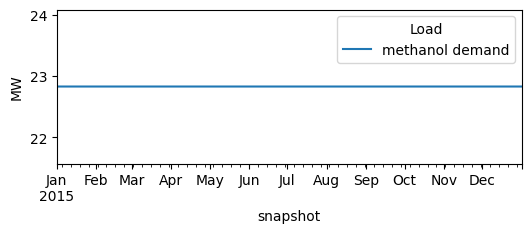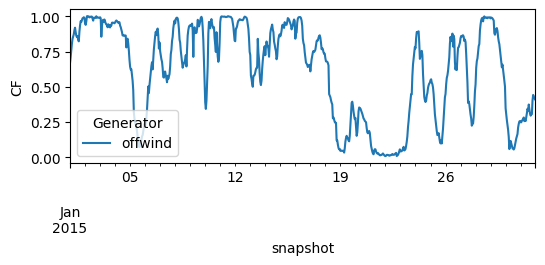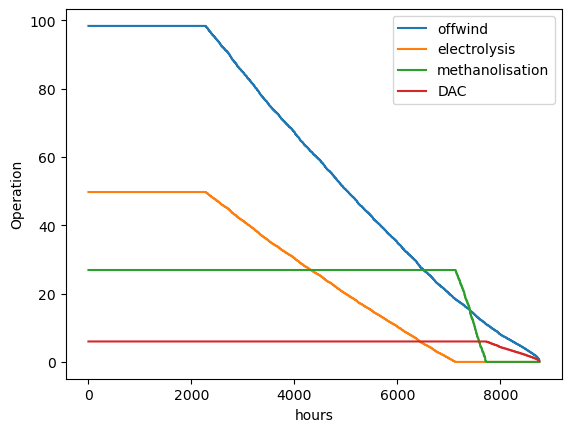Problem 12.2#
Integrated Energy Grids
Problem 12.1. Synthetic methanol production in an energy island.
In this problem, we want to build a stylized mode of methanol production in an energy island. Assume an offshore generator, an electrolyzer, a Direct Air Capture (DAC) unit ,and a methanolisation unit with the cost in Table. For the offshore generator, assume the capacity factors for Denmark.
An annual methanol demand of 200 GWh must be delivered and, for the sake of simplicity, assume that the island includes a hydrogen storage, a CO\(_2\), and a methanol storage with no cost. The electrolyzer efficiency is assumed to be 62%. The methanolisation plant requires hydrogen, CO\(_2\) and electricity as inputs. It produces 0.8787 MWh of methanol per MWh of hydrogen, 4.0321 MWh of methanol per tonne of CO\(_2\), and 3.6907 MWh of methanol per MWh of electricity.
The DAC unit requires MWh of electricity and MWh of heat to capture 1 tonne of CO\(_2\). Heat is assumed to be provided by a heat pump with a constant coefficient of performance (COP) of 3.
Note
If you have not yet set up Python on your computer, you can execute this tutorial in your browser via Google Colab. Click on the rocket in the top right corner and launch “Colab”. If that doesn’t work download the .ipynb file and import it in Google Colab.
Then install pandas and numpy by executing the following command in a Jupyter cell at the top of the notebook.
!pip install pandas pypsa
import matplotlib.pyplot as plt
import pandas as pd
import numpy as np
import pypsa
Prerequisites: handling technology data and costs#
We maintain a database (PyPSA/technology-data) which collects assumptions and projections for energy system technologies (such as costs, efficiencies, lifetimes, etc.) for given years, which we can load into a pandas.DataFrame. This requires some pre-processing to load (e.g. converting units, setting defaults, re-arranging dimensions):
year = 2030
url = f"https://raw.githubusercontent.com/PyPSA/technology-data/master/outputs/costs_{year}.csv"
costs = pd.read_csv(url, index_col=[0, 1])
costs.loc[costs.unit.str.contains("/kW"), "value"] *= 1e3
costs.unit = costs.unit.str.replace("/kW", "/MW")
defaults = {
"FOM": 0,
"VOM": 0,
"efficiency": 1,
"fuel": 0,
"investment": 0,
"lifetime": 25,
"CO2 intensity": 0,
"discount rate": 0.07,
}
costs = costs.value.unstack().fillna(defaults)
costs.at["OCGT", "fuel"] = costs.at["gas", "fuel"]
costs.at["OCGT", "CO2 intensity"] = costs.at["gas", "CO2 intensity"]
Let’s also write a small utility function that calculates the annuity to annualise investment costs. The formula is
where \(r\) is the discount rate and \(n\) is the lifetime.
def annuity(r, n):
return r / (1.0 - 1.0 / (1.0 + r) ** n)
annuity(0.07, 20)
0.09439292574325567
Based on this, we can calculate the marginal generation costs (€/MWh):
costs["marginal_cost"] = costs["VOM"] + costs["fuel"] / costs["efficiency"]
and the annualised investment costs (capital_cost in PyPSA terms, €/MW/a):
annuity = costs.apply(lambda x: annuity(x["discount rate"], x["lifetime"]), axis=1)
costs["capital_cost"] = (annuity + costs["FOM"] / 100) * costs["investment"]
We can now read the capital and marginal cost of onffhore wind and electrolysis
costs.at["offwind", "capital_cost"] #EUR/MW/a
np.float64(174556.22307975945)
costs.at["electrolysis", "capital_cost"] #EUR/MW/a
np.float64(188715.7758309984)
Retrieving time series data#
In this example, wind data from https://zenodo.org/record/3253876#.XSiVOEdS8l0 and solar PV data from https://zenodo.org/record/2613651#.X0kbhDVS-uV is used. The data is downloaded in csv format and saved in the ‘data’ folder. The Pandas package is used as a convenient way of managing the datasets.
For convenience, the column including date information is converted into Datetime and set as index
data_offwind = pd.read_csv('data/offshore_wind_1979-2017.csv',sep=';')
data_offwind.index = pd.DatetimeIndex(data_offwind['utc_time'])
The data format can now be analyzed using the .head() function to show the first lines of the data set
data_offwind.head()
| utc_time | BEL | DEU | DNK | GBR | NLD | SWE | FIN | FRA | IRL | NOR | |
|---|---|---|---|---|---|---|---|---|---|---|---|
| utc_time | |||||||||||
| 1979-01-01 00:00:00+00:00 | 1979-01-01T00:00:00Z | 0.513 | 0.875 | 0.986 | 0.522 | 0.484 | 0.712 | 0.470 | 0.296 | 0.676 | 0.232 |
| 1979-01-01 01:00:00+00:00 | 1979-01-01T01:00:00Z | 0.367 | 0.861 | 0.985 | 0.549 | 0.322 | 0.713 | 0.384 | 0.331 | 0.584 | 0.180 |
| 1979-01-01 02:00:00+00:00 | 1979-01-01T02:00:00Z | 0.372 | 0.845 | 0.978 | 0.551 | 0.267 | 0.711 | 0.321 | 0.343 | 0.466 | 0.161 |
| 1979-01-01 03:00:00+00:00 | 1979-01-01T03:00:00Z | 0.351 | 0.819 | 0.968 | 0.498 | 0.274 | 0.709 | 0.271 | 0.223 | 0.389 | 0.163 |
| 1979-01-01 04:00:00+00:00 | 1979-01-01T04:00:00Z | 0.338 | 0.787 | 0.957 | 0.457 | 0.274 | 0.708 | 0.224 | 0.189 | 0.270 | 0.168 |
We will use timeseries for Denmark in this excercise
country = 'DNK'
Join capacity and dispatch optimization#
For building the model, we start again by initialising an empty network, adding the snapshots, the electricity and the hydrogen bus.
n = pypsa.Network()
hours_in_2015 = pd.date_range('2015-01-01 00:00Z',
'2015-12-31 23:00Z',
freq='h')
n.set_snapshots(hours_in_2015.values)
n.add("Bus", "electricity")
n.add("Bus", "hydrogen")
n.add("Bus", "methanol")
n.add("Bus", "heat")
n.add("Bus", "co2")
n.snapshots
DatetimeIndex(['2015-01-01 00:00:00', '2015-01-01 01:00:00',
'2015-01-01 02:00:00', '2015-01-01 03:00:00',
'2015-01-01 04:00:00', '2015-01-01 05:00:00',
'2015-01-01 06:00:00', '2015-01-01 07:00:00',
'2015-01-01 08:00:00', '2015-01-01 09:00:00',
...
'2015-12-31 14:00:00', '2015-12-31 15:00:00',
'2015-12-31 16:00:00', '2015-12-31 17:00:00',
'2015-12-31 18:00:00', '2015-12-31 19:00:00',
'2015-12-31 20:00:00', '2015-12-31 21:00:00',
'2015-12-31 22:00:00', '2015-12-31 23:00:00'],
dtype='datetime64[ns]', name='snapshot', length=8760, freq=None)
Next, we add the methanol demand time series to the model. We add a “free” store in the hydrogen, methanol and CO2 buses.
annual_methanol_demand = 200000 #MWh
methanol_demand = annual_methanol_demand/8760*np.ones(8760)
n.add("Load",
"methanol demand",
bus = "methanol",
p_set=methanol_demand)
n.add("Store",
"hydrogen store",
bus = "hydrogen",
e_nom_extendable=True,
e_cyclic=True) # cyclic state of charge
n.add("Store",
"methanol store",
bus = "methanol",
e_nom_extendable=True,
e_cyclic=True)
n.add("Store",
"co2 store",
bus = "co2",
e_nom_extendable=True,
e_cyclic=True)
Index(['co2 store'], dtype='object')
Let’s have a check whether the data was read-in correctly.
n.loads_t.p_set.plot(figsize=(6, 2), ylabel="MW")
<Axes: xlabel='snapshot', ylabel='MW'>

We add now the offshore wind generator and set up the capacity to be extendable so that it can be optimized. We need to indicate the capacity factor or maximum power per unit ‘p_max_pu’
CF_wind = data_offwind[country][[hour.strftime("%Y-%m-%dT%H:%M:%SZ") for hour in n.snapshots]]
n.add(
"Generator",
"offwind",
bus="electricity",
p_max_pu=CF_wind.values,
capital_cost=costs.at["offwind", "capital_cost"],
marginal_cost=costs.at["offwind", "marginal_cost"],
p_nom_extendable=True,
)
Index(['offwind'], dtype='object')
So let’s make sure the capacity factors are read-in correctly.
n.generators_t.p_max_pu.loc["2015-01"].plot(figsize=(6, 2), ylabel="CF")
<Axes: xlabel='snapshot', ylabel='CF'>

We add the electrolyzer.
n.add(
"Link",
"electrolysis",
bus0="electricity",
bus1="hydrogen",
p_nom_extendable=True,
efficiency=costs.at["electrolysis", "efficiency"],
capital_cost=costs.at["electrolysis", "capital_cost"] #EUR/MW/a,
)
Index(['electrolysis'], dtype='object')
We add the methanolisation unit.
MWh_MeOH_per_MWh_H2 = 0.8787
MWh_MeOH_per_tCO2 = 4.0321
MWh_MeOH_per_MWh_e = 3.6907
n.add(
"Link",
"methanolisation",
bus0="hydrogen",
bus1="methanol",
bus2="electricity",
bus3="co2",
p_nom_extendable=True,
capital_cost=costs.at["methanolisation", "capital_cost"]* MWh_MeOH_per_MWh_H2, # EUR/MW_H2/a
#marginal_cost=costs.at["methanolisation", "VOM"]*options["MWh_MeOH_per_MWh_H2"],
efficiency=MWh_MeOH_per_MWh_H2,
efficiency2=-MWh_MeOH_per_MWh_H2/ MWh_MeOH_per_MWh_e,
efficiency3=-MWh_MeOH_per_MWh_H2/ MWh_MeOH_per_tCO2,
)
Index(['methanolisation'], dtype='object')
We add the direct air capture (DAC) unit. Since DAC needs heat as input, we assume that this is provided using a heat pump.
electricity_input = (
costs.at["direct air capture", "electricity-input"]
+ costs.at["direct air capture", "compression-electricity-input"]) # MWh_el / tCO2
heat_input = (
costs.at["direct air capture", "heat-input"]
- costs.at["direct air capture", "compression-heat-output"]) # MWh_th / tCO2
n.add("Link",
"DAC",
bus0="electricity",
bus1="heat",
bus2="co2",
capital_cost=costs.at["direct air capture", "capital_cost"] / electricity_input,
efficiency=-heat_input / electricity_input,
efficiency32=1 / electricity_input,
p_nom_extendable=True)
n.add(
"Link",
"heat pump",
bus0="electricity",
bus1="heat",
efficiency=3,
p_nom_extendable=True,
capital_cost=costs.at["central air-sourced heat pump", "capital_cost"], # €/MWe/a
)
Index(['heat pump'], dtype='object')
Model Run#
We can already solve the model using the open-solver “highs” or the commercial solver “gurobi” with the academic license
n.optimize(solver_name="highs")
WARNING:pypsa.consistency:The following buses have carriers which are not defined:
Index(['electricity', 'hydrogen', 'methanol', 'heat', 'co2'], dtype='object', name='Bus')
WARNING:pypsa.consistency:The following stores have carriers which are not defined:
Index(['hydrogen store', 'methanol store', 'co2 store'], dtype='object', name='Store')
WARNING:pypsa.consistency:The following links have carriers which are not defined:
Index(['electrolysis', 'methanolisation', 'DAC', 'heat pump'], dtype='object', name='Link')
WARNING:pypsa.consistency:Encountered nan's in static data for columns ['efficiency3', 'efficiency2'] of component 'Link'.
INFO:linopy.model: Solve problem using Highs solver
INFO:linopy.io:Writing objective.
Writing constraints.: 0%| | 0/14 [00:00<?, ?it/s]
Writing constraints.: 64%|██████▍ | 9/14 [00:00<00:00, 50.31it/s]
Writing constraints.: 100%|██████████| 14/14 [00:00<00:00, 15.34it/s]
Writing continuous variables.: 0%| | 0/7 [00:00<?, ?it/s]
Writing continuous variables.: 86%|████████▌ | 6/7 [00:00<00:00, 50.28it/s]
Writing continuous variables.: 100%|██████████| 7/7 [00:00<00:00, 42.57it/s]
INFO:linopy.io: Writing time: 1.1s
Running HiGHS 1.10.0 (git hash: fd86653): Copyright (c) 2025 HiGHS under MIT licence terms
LP linopy-problem-ht82j2_r has 210248 rows; 96368 cols; 420488 nonzeros
Coefficient ranges:
Matrix [3e-03, 3e+00]
Cost [2e-02, 2e+06]
Bound [0e+00, 0e+00]
RHS [2e+01, 2e+01]
Presolving model
96360 rows, 78845 cols, 254040 nonzeros 0s
70080 rows, 52565 cols, 201480 nonzeros 0s
Dependent equations search running on 26280 equations with time limit of 1000.00s
Dependent equations search removed 0 rows and 0 nonzeros in 0.00s (limit = 1000.00s)
70080 rows, 52565 cols, 201480 nonzeros 0s
Presolve : Reductions: rows 70080(-140168); columns 52565(-43803); elements 201480(-219008)
Solving the presolved LP
Using EKK dual simplex solver - serial
Iteration Objective Infeasibilities num(sum)
0 0.0000000000e+00 Pr: 8760(55684.9) 0s
10819 7.5175689704e+02 Pr: 6704(1.42073e+08) 5s
16483 1.7108812498e+03 Pr: 1040(8.88774e+06) 10s
18702 2.8060125796e+06 Pr: 21454(4.27386e+06) 16s
20386 3.8423230802e+06 Pr: 14191(2.18041e+06) 21s
22875 5.7676015561e+06 Pr: 19690(564869) 26s
Now, we can look at the results and evaluate the total system cost (in billion Euros per year)
n.objective / 1e9
0.05185793736250134
a) What is the optimum capacity of offshore wind, electrolyzer, DAC, and methanolisation that needs to be installed?
The optimised capacities in GW, notice that we are representing some technologies using generator components and other using link components, so we need to check both. Notice also that the capacities are expressed in terms of the inputs in bus 0.
n.generators.p_nom_opt
Generator
offwind 140.893299
Name: p_nom_opt, dtype: float64
n.links.p_nom_opt
Link
electrolysis 79.988255
methanolisation 30.614457
DAC 5.986756
heat pump 5.079672
Name: p_nom_opt, dtype: float64
b) What is the optimal storage capacity of hydrogen, CO\(_2\), and methanol, in absolute terms and relative to the annual demand?
n.stores.e_nom_opt
Store
hydrogen store 20489.674837
methanol store 8364.534882
co2 store 1399.919184
Name: e_nom_opt, dtype: float64
The optimal energy capacity of the methanol storage represents 4% of the annual methanol demand.
n.stores.e_nom_opt['methanol store']/n.loads_t.p_set['methanol demand'].sum()
0.04182267441186075
The optimal energy capacity of the hydrogen storage represents 9% of the annual hydrogen production.
n.stores.e_nom_opt['hydrogen store']/(-n.links_t.p1['electrolysis'].sum())
0.09002138639544652
The optimal energy capacity of the CO$_2$ storage represents 3% of the annual co2 captured.
n.stores.e_nom_opt['co2 store']/(-n.links_t.p2['DAC'].sum())
0.02822307070965491
c) Plot the duration curve for the offshore wind generation, electrolyzer, DAC and methanolisation operation and discuss the results.
Electrolysis, methanolisation and DAC get an utilization factor of 0.52, 0.85 and 0.95 respectively.
duration_offwind=n.generators_t.p["offwind"].sort_values(ascending=False)
duration_electrolysis=-n.links_t.p1["electrolysis"].sort_values(ascending=True)
duration_methanolisation=-n.links_t.p1["methanolisation"].sort_values(ascending=True)
duration_dac=-n.links_t.p2["DAC"].sort_values(ascending=True)
plt.plot(duration_offwind.values, label='offwind')
plt.plot(duration_electrolysis.values, label='electrolysis')
plt.plot(duration_methanolisation.values, label='methanolisation')
plt.plot(duration_dac.values, label='DAC')
plt.ylabel("Operation")
plt.xlabel("hours")
plt.legend()
<matplotlib.legend.Legend at 0x2580e909c40>

(duration_electrolysis/duration_electrolysis.max()).mean()
0.5224902306786894
(duration_methanolisation/duration_methanolisation.max()).mean()
0.8487087885003746
(duration_dac/duration_dac.max()).mean()
0.9458081519881748
At what cost can the methanol be produced and how does it compare to current methanol price?
We can calculate the cost ob producing H\(_2\) by using the total system cost or averaging the marginal price of the hydrogen bus.
n.objective / n.loads_t.p_set['methanol demand'].sum()
259.2896868125066
n.buses_t.marginal_price['methanol'].mean()
259.2896868126318
Assuming 5.53 kWh/kg of methanol, 259 EUR/MWh corresponds to 1.43 EUR/kg, while the current price for methanol is around 0.6 EUR/kg (while emitting CO2)
259/1000*5.53
1.4322700000000002

